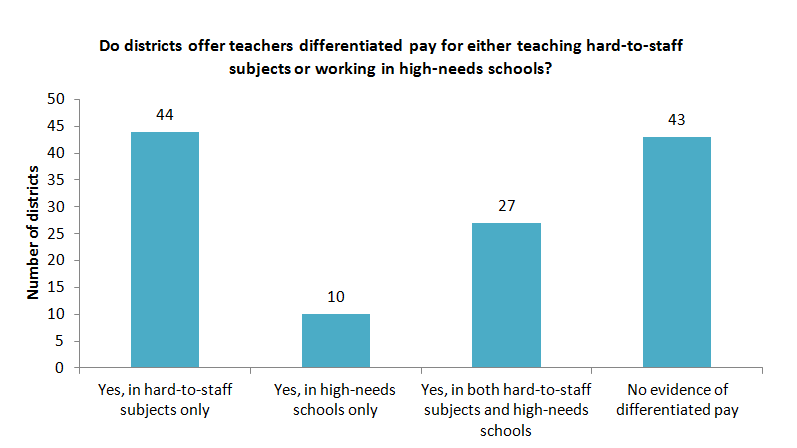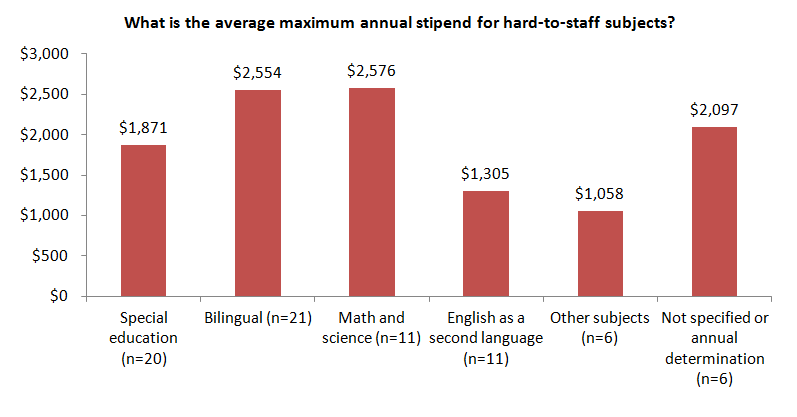District Trendline, previously known as Teacher Trendline, provides actionable research to improve district personnel policies that will strengthen the teacher workforce. Want evidence-based guidance on policies and practices that will enhance your ability to recruit, develop, and retain great teachers delivered right to your inbox each month? Subscribe here.
Every teacher has heard the saying, “no one goes into teaching to get rich.” However, even the most altruistic teachers still have bills to pay. Money can play a significant role in retaining, rewarding, and –yes—recruiting great teachers.
For decades now, some reformers have argued that it doesn’t make much sense to base teachers’ pay only on their education and experience with no accommodation for the subject they teach or the type of school in which they work. Instead, the argument goes, we should compensate teachers in a manner that reflects the challenges of their assignment as well as the laws of supply and demand. In so doing, districts will attract more teachers to the schools and subjects where they are most needed.
This month, Trendline asks the question “Just how common is differentiated pay for teachers?” To answer, we look at two common types of differentiated pay: more compensation either for teaching a hard-to-staff subject or for teaching in high-needs schools.
Prevalence of differentiated pay
Perhaps surprisingly, differentiated pay is now common in the 124 districts in the Trendline sample. Two-thirds of the large districts in our database (82 of 124) offer some form of differentiated pay based on subject or school. However, there is clear preference for offering differentiated pay for hard-to-staff subjects. Districts are twice as likely to offer additional compensation for teaching hard-to-staff subjects as they are for working in high-needs schools. Only 22 percent of large districts offer both forms of differentiated pay.

Although a district contract may have language allowing differentiated pay, not all districts with this option put it into practice. For example, several districts have policies that articulate the option of offering new teachers in hard-to-staff subjects additional pay, or that stipulate that the superintendent “may” approve supplemental pay. Some districts are supposed to annually name the high-needs schools or hard-to-staff subjects for the purpose of awarding additional pay to teachers, leaving the door open to no subjects or schools being designated as eligible for differentiated pay in any given year. Because our analysis is an examination of policy, not practice, we still count those 19 districts as a “yes” in the table above.
Hard-to-staff subjects
The authority to pay teachers more money in hard-to-staff subjects makes those subjects more attractive to would-be teachers and the district more attractive to teachers with a certification in short supply. The majority (71) of the districts have policies that offer teachers an incentive for working in subjects with teacher shortages. Most package their additional compensation through annual stipends. Other common forms of incentives include compensating new hires in these subject areas by starting them at a higher level on the salary schedule or paying them on a separate salary schedule altogether.

One-time or limited stipends can take the form of recruitment bonuses. For instance, the Hawaii Department of Education offers the largest recruitment bonus: teachers certified to teach special education who agree to serve in a special education classroom for three years earn a one-time $10,000 reward paid over the three years.
All seven districts in our sample that use a separate, more generous salary schedule do so only for their special education teachers.
The “Other” category in the graph above includes districts that pay the moving or housing expenses for new hires in critical needs areas. This includes Douglas County School Districtin Colorado, which has the most unusual salary schedule in the database. It divides its salary schedule into salary bands based on the subjects teachers teach. Those who teach the highest demand subjects garner the highest base pay. For example, the district starts second grade teachers with a salary of $36,000, while math and science teachers start at $43,000. (You can view this unique salary schedule here.)
What subjects are hard-to-staff?
The most commonly hard-to-staff subjects, at least as specified in teacher contracts, are special education (36 districts), bilingual education (24), math and science (14), and English as a Second Language (12). Not all districts have a set definition of hard-to-staff subjects. In 38 percent of districts, teacher contracts do not list specific subjects, instead leaving that decision up to the superintendent or some annual process.

How much can teachers earn for working in hard-to-staff subjects?
The amount of annual stipend teachers can earn varies quite a bit from subject to subject and district to district. Across the districts that offer annual stipends, math and science teachers qualify for the highest average annual stipend of $2,576. Next are bilingual teachers who can qualify for an average annual stipend of $2,554.

The amount of these annual stipends for working in a hard-to-staff subject varies greatly. The School District of Palm Beach County(FL) offers teachers in critical shortage areas only $100 while special education teachers in El Paso Independent School District and math and science teachers in Duval County Public Schools can earn bonuses up to $5,000.
High-needs schools
Offering additional compensation for working in high-needs schools is much less common. Only 37 districts (compared to 71 for hard-to-staff subjects) offer teachers incentives to work at high-needs schools–most commonly defined as those schools with the lowest student performance or the highest student poverty rates. Some districts also include schools in specific geographic locations or that serve unique populations such as alternative education schools. For example, teachers in Long Beach Unified School District who work on Catalina Island (22 miles off the California coast) are eligible for extra pay.

Among those districts that offer additional compensation for working in high-needs schools, 84 percent offer this payment as some form of annual stipend. Other kinds of incentives include loan forgiveness or tuition reimbursement. Metropolitan Nashville Public Schools has a unique policy of paying teachers in high-needs schools to receive up to 10 extra days of professional development, perhaps intended to ensure that teachers are getting access to the additional support they may need.
Again, the variety is significant. Stipends range from as little as $100 for teachers in specifically named Title I schools in Seminole County Public Schools to as much as $20,000 for highly effective teachers in the District of Columbia Public Schools if they teach in the district’s highest-needs schools.
Connecting differentiated pay to performance
There are 11 districts that combine differentiated pay with some measure of teacher effectiveness or performance. These districts identify certain qualifications a teacher must have, such as earning a certain evaluation rating, in order to earn extra compensation for working in hard-to-staff subjects or high-needs schools.
For example, in the District of Columbia Public Schools, only teachers who receive the highest evaluation rating are eligible for bonuses for working in hard-to-staff subjects. These bonuses are twice as large for highly effective teachers working in high poverty schools as for teachers in low poverty school ($5,000 compared to $2,500). Similarly, only highly effective teachers in Newark Public Schools are eligible for bonuses for working in hard-to-staff subjects and for working in high-needs schools. Combined, these bonuses can be as much as $12,500 per year. In the Dallas Independent School District, bonuses for working in the district’s highest-needs schools range from $6,000 to $10,000, depending on a teacher’s evaluation rating.
Teachers, district officials, and researchers alike continue to investigate how teacher compensation can be better structured to support district hiring goals. From where we sit, a starting point to understanding the impact of differentiated compensation on recruitment, retention, and student achievement is first understanding the new reality. Teachers are no longer paid the same regardless of their subject or assignment. In fact, our data demonstrate that teacher compensation policies come in all shapes and sizes.
To see more details on these and other district policies, visit the Teacher Contract Database.
The Teacher Contract Database includes information on 147 school districts and 2 charter management organizations in the United States including: the 100 largest districts in the country, the largest district in each state, and the member districts of the Council of Great City Schools. The database features answers to over 100 policy questions and provides access to teacher contracts, salary schedules, and board policies in addition to relevant state laws governing teachers.
More like this

Beyond one-size-fits-all: The case for differentiated teacher compensation

Research that moved minds: Top Teacher Quality Bulletin articles of 2024

When “do no harm” is impossible, how can districts design teacher layoffs to do the least damage?

